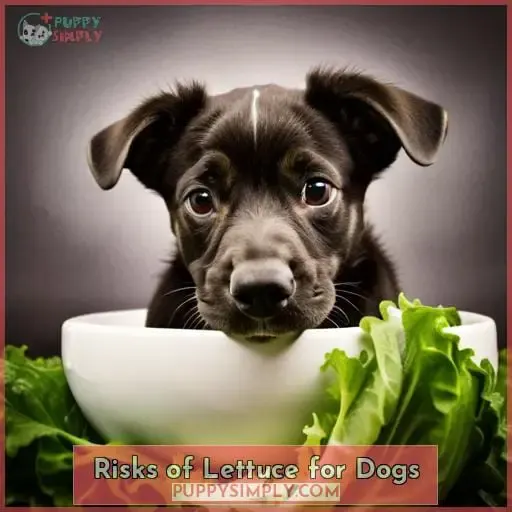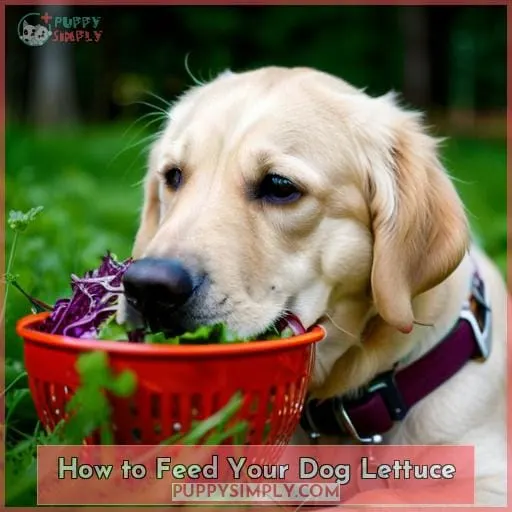This site is supported by our readers. We may earn a commission, at no cost to you, if you purchase through links.
 Surprising as it may seem, many dog owners are asking: can dogs eat salad? The answer is yes – but with a few precautions. Lettuce and other greens provide essential vitamins and minerals to your pup’s diet, plus they’re low in calories and high in fiber.
Surprising as it may seem, many dog owners are asking: can dogs eat salad? The answer is yes – but with a few precautions. Lettuce and other greens provide essential vitamins and minerals to your pup’s diet, plus they’re low in calories and high in fiber.
However, there are potential risks such as allergies or pesticide residue that you should be aware of before feeding your pooch some leafy greens.
On top of this, lettuce has the potential to cause diarrhea if consumed in large amounts due to its fibrous nature – making moderation key when considering how much lettuce is safe for dogs to eat! In this article, we’ll cover all the nutritional facts about giving salads (and other greens!) to Fido so you can make an informed decision about what’s best for their health and wellbeing.
Table Of Contents
Key Takeaways
- Lettuce contains vitamins, minerals, and fiber; it is low in calories.
- Introduce new greens slowly and monitor for allergic reactions.
- Lettuce should not be the sole protein source for dogs.
- Consult a vet before adding lettuce or greens to a dog’s diet.
Is Lettuce Safe for Dogs?
Providing proper nutrition for your pup is important, and one way to do so is by incorporating lettuce into their diet in moderation – as it can help boost immunity, aid digestion, and promote gut health.
Lettuce contains 90% water, so it’s a great low-calorie snack or a good training treat.
The iceberg variety has fewer nutrients than romaine or spinach but may be offered in small pieces as part of a balanced diet. Its high fiber content makes it an excellent choice for dogs that are deficient in this area.
Additionally, try not to give too much at once since excessive amounts can cause diarrhea, which isn’t ideal for them (or you!). Allergies are possible with some pups, while the iceberg variety tends to have more pesticide residue if not organic.
Both things are worth keeping an eye out for when offering food items that aren’t regular staples of their daily meal plan.
In summary, provide balanced nutritious meals, including occasional servings of leafy greens like lettuce.
Benefits of Lettuce for Dogs
Lettuce is an ideal snack for your pup as it contains a high level of water content, making it low in calories yet rich in fiber, which can support gut health. Additionally, the vitamins and minerals found in lettuce, such as A, C, K, and potassium, are essential to maintain better overall health.
High Water Content
Lettuce is an ideal snack for your pup, boasting a high water content. Dogs love the crunch, and it can be part of sound nutrition habits. With valuable information on possible risks and benefits in moderation, lettuce can be a great addition to their diet! Plus, with 90% water content, it helps keep them hydrated while providing low calories yet still being packed with fiber, vitamins A/C/K, and potassium – making it perfect for overweight pups or those wanting to lose some weight.
Low in Calories
You’ll be glad to know that lettuce is low in calories, so it’s a great choice for your pup if he needs to shed some pounds. Safe and nutritious, this veggie can help set smaller dogs on the right path for puppy nutrition and lifelong health.
Plus, it has 90% water content, which helps with hydration too! Feeding lettuce as part of their regular diet will ensure they get all the vitamins and minerals needed while still being able to maintain a healthy weight.
Rich in Fiber
Adding lettuce to your pup’s diet can help keep their gut healthy with its high fiber content. This is essential for overweight dogs that may be prone to kidney damage. Lettuce is a nutritious option due to the vitamins, minerals, and fiber it contains – plus, oxalic acid levels are low.
Fiber helps regulate digestion and boosts immunity while providing crucial energy without extra calories or fat! Lettuce provides an excellent source of dietary fiber, making it easier for pets to stay regular and maintain optimal weight health when fed in moderation as part of a balanced diet alongside proteins and fatty acids from other sources.
Contains Essential Vitamins and Minerals
You’ll find that lettuce is packed with essential vitamins and minerals like A, C, K, and potassium to help keep your pup healthy. Calcium oxalate provides large amounts of vitamins, while the red-orange pigment found in pup greens boosts immunity.
This nutrient combination supports your dog’s body’s ability to fight off illnesses more effectively than other foods.
Risks of Lettuce for Dogs
Being aware of the risks associated with feeding lettuce to your dog is important. Potential risks include diarrhea if too much is consumed, allergies in some dogs, and pesticide residue from non-organic sources.
To ensure a safe diet for your pup, it’s essential to understand these potential downsides before making any changes or introducing new foods into their daily meals.
Potential for Diarrhea
Overindulging on lettuce can lead to diarrhea, so be sure to keep an eye on your pup’s intake. Iceberg varieties are especially low in nutritional content and may not provide enough of the exact nutrients your dog needs.
While some natural compounds found in lettuce can benefit a dog’s health, they also contain harmful ones that could cause digestive problems.
A lot of Americans feed their dogs too much salad without considering its effects. Small amounts are fine, but beware if you begin introducing more than usual! Too much consumption may result in gastrointestinal issues due to the lack of essential vitamins and minerals needed for a balanced diet.
Allergies
Be aware that certain lettuce varieties can cause allergies in some dogs, so introduce it gradually and observe carefully. Allergies may manifest if the dog is exposed to different types of lettuce or leftover salad.
The body’s ability to tolerate these foods varies from one canine to another, with some experiencing severe gastric irritation and bladder stones when eating too much lettuce. Always monitor your pup closely for any signs of discomfort after giving them a bite of this leafy vegetable before introducing it into their diet more regularly.
Pesticide Residue
Pesticide residue can be a concern if lettuce is not organic, so make sure to buy the cleanest option available. Lettuce may seem like a popular meal option for dogs, but it’s important to keep in mind that its small size and high water content mean pesticides can accumulate easily.
This could overwhelm your pup’s body’s ability to process them safely; try avoiding big pieces of lettuce or feeding in moderation as much as possible.
How Much Lettuce Can a Dog Eat?
It’s important to know the amount of lettuce that is safe for your pup, as too much can cause gastrointestinal distress.
Here are four key things to remember:
- Dietary sources of lettuce should be limited and kept in moderation when considering a balanced diet for dogs.
- Fiber intake from other sources such as fruits and vegetables should also be considered in addition to the amounts of lettuce fed each day or week depending on size/weight needs of your dog.
- Safe amounts will vary based on breed size, age, activity level, and health conditions. So consult with a vet before introducing any new foods into their regular diet routine if you have concerns about proper nutrition levels best suited specifically for them – or if they have allergies or sensitivities.
- Organic options are preferable since some conventional lettuces may contain pesticide residue which could lead to potential health risks over time, especially if eaten regularly.
What Kind of Lettuce is Best for Dogs?
When it comes to feeding your pup, romaine, arugula, and iceberg lettuce are great choices — but don’t forget the nutrition factor. There are a few types of lettuces that provide more nutritional value than others.
Spinach and kale contain high levels of vitamins A, C, K, as well as potassium and other minerals, which can be beneficial for dogs.
However, moldy lettuce should also be avoided due to potential toxins or bacteria present in this type of vegetable. It is important to keep an eye out when buying these vegetables at the grocery store since some varieties may have been sprayed with pesticides, which could cause adverse reactions in your pet if ingested too frequently or in large amounts.
Aside from avoiding pesticide residues on vegetables you choose for dog snacks, it is important to pay attention to how much you feed them at one time; no more than 2 1/4 cups per day depending on their size.
Otherwise, they might experience digestive issues such as diarrhea or gas buildup caused by too much fiber intake. If introducing something new into their diet, make sure you start slowly while monitoring any possible reactions so that allergies can also be ruled out right away (especially with certain breeds).
Lettuce recipes combining different types along with proteins like chicken help ensure complete nutrition while providing variety. However, remember not all veggies offer the same benefits, so consult a vet before making changes regarding the overall diet balance, particularly when including leafy greens like spinach, romaine, arugula, etc.
How to Feed Your Dog Lettuce
You can boost your pup’s diet by adding lettuce as a topper or mix-in, but make sure you do it in moderation and thoroughly wash the leaves.
Here are five important tips for feeding your dog lettuce:
- Soak the leaves first to remove bacteria and pesticide levels.
- Choose variety selection carefully—romaine, arugula, and iceberg have fewer nutrients than spinach or kale, so opt for those if possible!
- Chop into small pieces before serving for easier digestion and absorption of nutrients; cook broccoli if desired too!
- Monitor reactions after introducing new foods like lettuce slowly over time—allergies are possible in some dogs, so keep a watchful eye out for any signs of discomfort from digestive upset or skin rashes/itchiness, etc.
- Consider overall nutrition needs when incorporating vegetables into regular meals – balance with proper protein, fat, vitamins, and minerals as part of a complete diet plan tailored specifically towards an individual pup’s needs, not just one food type alone such as only salads, greens, or lettuce all day long every single day without considering other essential nutritional factors also required that provide full spectrum nutrient support necessary.
Other Greens Dogs Can Eat
Aside from lettuce, there are other greens your pup can munch on that offer even more health benefits – think of them as a salad for dogs! Dandelion greens help improve the liver and gallbladder functions while also providing vitamin A, C, and K.
Collard greens contain high levels of antioxidants like beta-carotene, which aid in healthy cell growth.
Swiss chard is full of vitamins B6, magnesium, and iron, which help support energy production in the body.
Mustard greens provide folate along with protective compounds such as glucosinolates, plus lutein for eye health.
And lastly, turnip greens are an excellent source of calcium intake, helping strengthen bones at any age!
| Dandelion Greens | Collard Greens | Swiss Chard | Mustard Greens | Turnip Greens | |
|---|---|---|---|---|---|
| Benefits | Liver & GB Functioning | Antioxidants Beta Carotene | Vitamins B6 + Magnesium Iron | Folate + Glucosinolates Luteins | Calcium Strengthens Bones |
Frequently Asked Questions (FAQs)
Are other vegetables safe for dogs to eat?
Yes, many other vegetables are safe for dogs to eat. For example, carrots can be a great source of vitamins and minerals; however, like lettuce, they should be served in moderation.
How often should a dog eat lettuce?
Lettuce is safe for dogs in moderation. Feed no more than 2 1/4 cups per day, depending on your pup’s size. Start slowly and watch for reactions; consult a vet if unsure of changes to the diet.
What are the signs of a lettuce allergy in dogs?
Signs of a lettuce allergy in dogs can include vomiting, diarrhea, itching, and skin rashes. If your dog displays any of these symptoms after eating lettuce, it is best to consult with a vet immediately.
What are the alternatives to feeding lettuce to dogs?
Feed your pup alternatives to lettuce like cooked vegetables, such as carrots, green beans, and squash. These provide essential vitamins and minerals without the risk of allergies or digestive issues.
Is lettuce a good source of protein for dogs?
No, lettuce is not a good source of protein for dogs. It contains some vitamins and minerals, but its 90% water content means it lacks the necessary macronutrients to provide adequate nutrition.
Conclusion
In the words of the wise, ‘a stitch in time saves nine’, it’s important to consider your dog’s dietary needs. Can dogs eat salad? Absolutely! Lettuce is generally safe for dogs to consume in moderation and offers a range of nutritional benefits.
It has high water content, low calories, high fiber, and essential vitamins and minerals. However, there are some risks to consider, such as the potential for diarrhea, allergies, and pesticide residue.
When feeding your pup lettuce, it’s important to give them the right amount based on their size and the right kind. Additionally, there are other green vegetables that your pup can enjoy. Ultimately, when it comes to introducing new foods to your pup’s diet, it’s important to consult with your vet to ensure they’re getting the proper nutrition.













